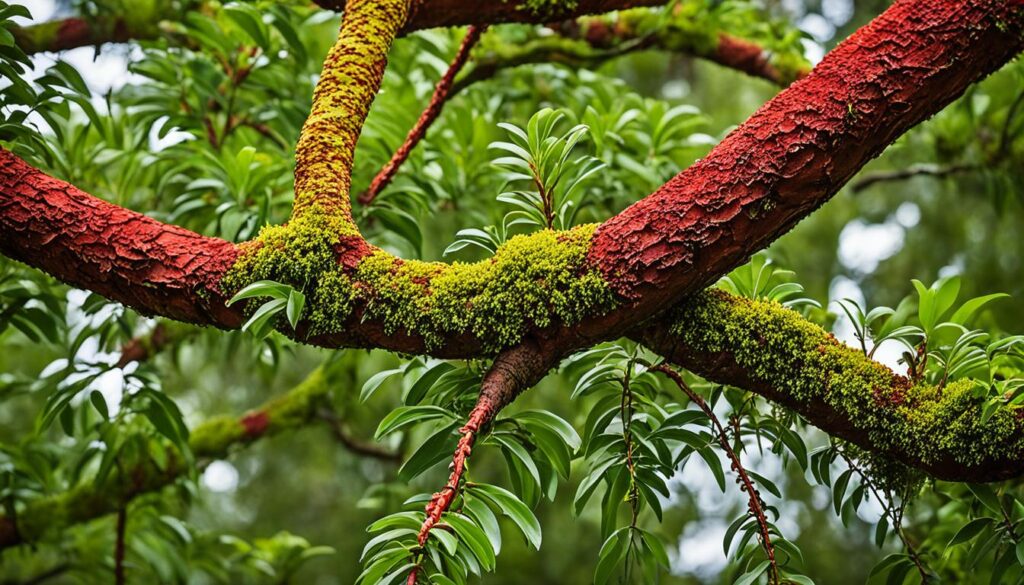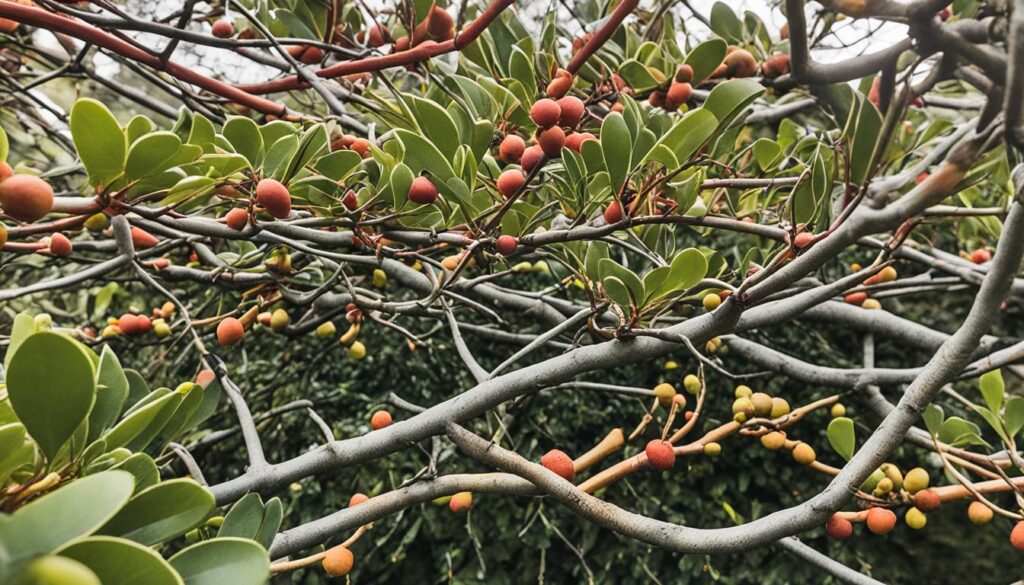
The Arbutus unedo, also known as the Strawberry Tree, is an evergreen tree. It belongs to the Ericaceae family. This tree is loved for its looks and the special fruits it has. You’ll learn about Arbutus unedo care and its interesting facts in this article.
Learning about Arbutus unedo cultivation shows its strength and beauty. This guide gives you important facts and tips for the tree’s health and landscaping. For more plant care tips, check out this comprehensive guide.
Introduction to Arbutus unedo
The Arbutus unedo, also known as the Strawberry Tree, is a fascinating part of Mediterranean flora. It’s an evergreen tree known for its unique look and interesting fruit. It comes from the Mediterranean Basin and parts of Western Europe.
Its history links back to early human activities. It was found in Ireland with Spanish miners during the Bronze Age.
This tree is loved for its beautiful leaves and small, red fruits that look like strawberries. These fruits take about a year to get ready, making it interesting for gardeners and nature lovers.
It can grow well in many types of soil. This makes it popular in different gardens.
If you’re planning a garden or want a special tree for your yard, the Strawberry Tree is a great choice. It adds beauty and is easy to care for.
Characteristics of the Arbutus unedo Tree

The Arbutus unedo, also known as the Strawberry Tree, is a beautiful tree. It has many features that make it stand out. Its bark and leaf structure are especially interesting.
Physical Appearance
The Arbutus unedo can grow up to 15 meters tall. It has Arbutus unedo appearance that includes reddish-brown bark. This bark peels off to show a smooth, cinnamon-colored layer underneath.
When it blooms, from October to April, it shows small, bell-shaped flowers. These flowers may be white, red, or green, adding beauty to the tree.
Bark and Leaf Structure
The Arbutus unedo bark is very unique. It has a special texture that changes over time. This bark protects the tree and makes it look interesting.
The Arbutus unedo leaf structure includes shiny, dark green leaves with jagged edges. These leaves stay green all year, making the tree evergreen. The leaves have pink stalks that help them hold water, which is important for survival.
| Characteristic | Description |
|---|---|
| Height | Up to 15 meters |
| Bark Color | Reddish-brown with a smooth cinnamon layer |
| Leaf Type | Glossy dark green leaves with serrated edges |
| Flower Appearance | Clusters of small, bell-shaped blooms, mainly white |
Growing Conditions for Arbutus unedo

To grow the Strawberry Tree (Arbutus unedo) well, you need to know its soil, climate, and sunlight needs. By understanding these, you can make your garden perfect for it. This ensures the tree grows well and gives its special fruits.
You can make a great place for the tree by meeting its Arbutus unedo soil requirements. Also, provide the right conditions it likes.
Preferred Soil Types
The Strawberry Tree likes soils that drain well and can be different types. It can grow in acidic or alkaline soils, making it easy to fit into many gardens. Sandy, loamy, or clay soils work well as long as they drain well.
Don’t put the tree in a place where it gets too wet. This can hurt its roots. Choose a spot with good drainage for the best growth.
Climate and Sunlight Requirements
It’s important to know the Arbutus unedo climate for its growth. This tree does best in mild climates and loves full sun. It can handle some drought but does better with lots of sunlight.
The Strawberry Tree sunlight needs are at least six hours of direct sunlight a day. It can handle coastal winds but does best in a spot protected from harsh weather.
| Criteria | Optimal Conditions |
|---|---|
| Soil Type | Sandy, Loamy, or Clay |
| Drainage | Well-drained |
| Climate | Mild |
| Sunlight | At least 6 hours of full sun |
| Drought Tolerance | Moderate |
For more tips on growing plants, check out various resources for gardeners at all levels.
Arbutus unedo Care and Maintenance

Caring for the Arbutus unedo, also known as the Strawberry Tree, is key. It needs the right amount of water, food, and trimming. With a good care plan, you’ll get a tree that blooms and fruits well.
Watering and Fertilization
Watering your Arbutus unedo right is very important, especially when it’s young. Give it deep water to help its roots grow strong. Make a watering plan that fits the tree’s needs, especially in hot, dry weather.
Use soil that drains well to prevent root rot from too much water. For Arbutus unedo fertilization, give it a balanced fertilizer every year. But don’t overdo it, as too much can harm the fruit production. Watch the tree and adjust the food as needed.
Pruning Techniques for a Healthy Tree
Pruning your Strawberry Tree regularly is a must. Prune in late spring or early summer to help it grow and produce fruit well. Cut out dead, damaged, or too-close branches to let more light and air in.
Following these steps in Strawberry Tree maintenance keeps your Arbutus unedo healthy and full of fruit. If you like to eat healthy foods, you might want to learn about cucumbers. They’re full of nutrients and good for you. You can learn more about them here.
Importance of Arbutus unedo Fruit
The Arbutus unedo fruit, also known as the strawberry tree fruit, is very important. It is used in cooking and helps wildlife. Even though it tastes mild, it can be made into many tasty dishes.
Edibility and Culinary Uses
The Arbutus unedo fruit is not just for eating. It’s used in Strawberry Tree culinary uses to make jams and liqueurs. In Portugal, it’s turned into a popular drink called «medronho.»
It can also be used in desserts and sauces. This shows how versatile the fruit is in cooking.
Benefits for Wildlife
The Arbutus unedo is important for nature too. Its flowers attract pollinators, helping other plants grow. The ripe fruits are a food source for many birds and mammals.
This helps the Strawberry Tree ecosystem stay healthy. The tree’s leaves protect animals in winter. It’s a key part of their survival.
| Aspect | Culinary Uses | Wildlife Benefits |
|---|---|---|
| Edibility | Jams, Liqueurs (e.g., medronho) | Food source for birds and mammals |
| Texture | Somewhat mealy | Nectar provider for pollinators |
| Flavor | Subtle | Provides shelter during winter |
More people want gluten-free foods, so companies are making more options. Food manufacturers are paying attention to this trend. They’re making sure there are many food choices for everyone.
Common Diseases Affecting Arbutus unedo
The Arbutus unedo, also known as the Strawberry Tree, is tough. But, it can still get sick. Knowing the signs of Arbutus unedo diseases helps you act fast. Learning how to treat and prevent these diseases keeps your tree healthy.
Identifying Symptoms of Common Diseases
Arbutus unedo faces problems with root rot and leaf spot diseases. Spotting these diseases early is key to managing them well. Look out for these signs:
- Yellowing leaves: This could mean the tree lacks nutrients or is sick.
- Wilting: This is a sign of root rot.
- Unusual growth patterns: If the tree grows strangely, it might be sick.
Treatment and Prevention Strategies
Act fast if you see signs of disease in your Arbutus unedo. Using the right fungicides can help. Also, cut out any infected parts to stop the disease from spreading.
Preventing Strawberry Tree diseases is just as crucial. Start with:
- Watering your tree right to avoid too much water.
- Picking trees that are resistant to diseases.
These steps will make your Arbutus unedo stronger and less likely to get sick.
Landscaping Ideas Featuring Arbutus unedo
Adding the Arbutus unedo to your garden makes it look better and work better. It’s known for its bright leaves and special fruit. This tree is great for parks, gardens, and places with a Mediterranean feel. It looks good all year and can be the main tree or add to borders.
Using Arbutus unedo as an Ornamental Tree
The Arbutus unedo is a great choice for making your garden look beautiful. Its green leaves and fruits that look like strawberries make it a great centerpiece. You can design a whole garden around it or add it to an existing one. Either way, it will make your outdoor area look amazing.
Creating a Wildlife-Friendly Garden
For a wildlife garden with Arbutus unedo, pair it with other native plants. This makes your garden more lively and helps local animals. It also makes your garden a place where different plants and animals can live together. This helps the environment and makes your garden peaceful and full of life.



